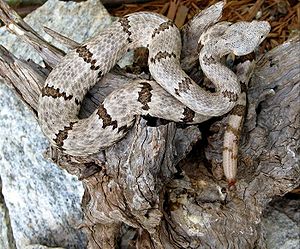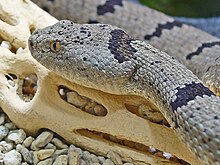Rock rattlesnake
| Rock rattlesnake | ||||||||||||
|---|---|---|---|---|---|---|---|---|---|---|---|---|

Rock rattlesnake ( Crotalus lepidus ) |
||||||||||||
| Systematics | ||||||||||||
|
||||||||||||
| Scientific name | ||||||||||||
| Crotalus lepidus | ||||||||||||
| ( Kennicott , 1859) |
The rock rattlesnake ( Crotalus lepidus ), also known as mountain rattlesnake , is a species of rattlesnake ( Crotalus ) that can be found from southwest Texas to central Mexico at altitudes of up to 3,000 meters.
features
The rock rattlesnake is a medium-sized rattlesnake with an average body length of about 60 to 70 centimeters, but can be up to 80 centimeters long in individual cases. The head is small and flat and the tail rattle is relatively large.
The species varies a lot in its body color. The typical basic color is gray to green-gray with a pattern of widely spaced black or dark-gray crossbars. There are also brown specimens or those in which the crossbars are reduced to a series of small black dots or others with additional spots between the crossbars. They also have a sexual dimorphism that is rather unusual for the rattlesnakes: the males are usually greenish-gray, while the females are light gray to brownish gray. Almost all specimens have a distinct black temple band that extends from the eyes to the corners of the mouth.
distribution and habitat
The distribution area of the rock rattlesnake extends from southeastern Arizona in a strip parallel to the state border with Mexico through southern New Mexico to southwest Texas and wedge-shaped to the south in central Mexico, although the coastal regions are not inhabited by this species. The snake occurs at heights of up to 3,000 meters.
As a habitat, the snake prefers rocky areas within mixed pine and oak forests.
Snake venom
The rock rattlesnakes produce only a relatively small amount of snake venom. It varies greatly in effect; As a rule, it mainly leads to local tissue destruction and pain, which is followed by general nausea . In some populations in Chihuahua , Arizona and New Mexico, however, the venom is much stronger and, like that of the Mojave rattlesnake, contains parts of neurotoxins that act on the central nervous system - the venom effect is increased 3 to 100 times. However, deaths from the bite of this snake have not yet been documented.
Systematics
There are currently four subspecies of the rock rattlesnake:
- C. l. klauberi with distinct black bars in Arizona, southwest New Mexico and northwest parts of the distribution area in Mexico
- C. l. lepidus in southeast New Mexico and southwest Texas to northeast Mexico, often with little clear crossbars
- C. l. maculosus in the southwestern part of the distribution area in Mexico, usually with a speckled pattern on a brownish-gray base color
- C. l. morulus in the southern part of the distribution area in Mexico, usually with crossbars and individual spots in between on a rather brownish-gray base color.
Especially the delimitation of the two subspecies C. l. klauberi and C. l. lepidus is under discussion, however, as they can both be morphologically very diverse. However, no conclusive results could be obtained from an investigation of the poison composition that was supposed to clarify this question.
supporting documents
- ↑ Eppie D. Rael, Jerry D. Johnson, Oscar Molina, Hugh K. McCrystal: Distribution of a Movave Toxin-Like Protein in Rock Rattlesnake ( Crotalus lepidus ) Venom. In: Jonathan A. Campbell, Edmund D. Brodie Jr .: The Biology of the Pitvipers. Selva, Tyler (Texas) 1992; Pp. 21-40; ISBN 0-9630537-0-1
literature
- Chris Mattison: Rattlers! - A natural history of rattlesnakes. Blandford, London 1996; P. 113; ISBN 0-7137-2534-6
Web links
- Crotalus lepidus in The Reptile Database
- Crotalus lepidus inthe IUCN 2013 Red List of Endangered Species . Posted by: Hammerson, GA, Frost, DR & Santos-Barrera, G., 2007. Retrieved October 5, 2013.


